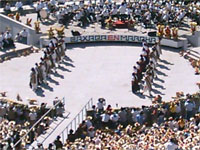Home » Mexico Destinations » Oaxaca » Oaxaca Events » Guelaguetza
Guelaguetza - Lunes del Cerro
 Every July, the southern state of Oaxaca holds its biggest fiesta. It is called the Guelaguetza and it includes dancing, acting out legends, lots of regional dress and good food. It is one of the main tourist events in the state and its roots go all the way back to pre-Colombian times. The name Guelaguetza comes from the Zapotec and means the great courtesy. It is the custom among these indigenous peoples to help one another during big events, such as weddings, births, and the planting and harvesting of crops. In fact, many of them are too poor to hire help, and their neighbors make it possible for them to raise a good crop. The names of the people that help are taken down, so that the people benefited can repay the favor at some future date. The big fiesta was named after this custom. The date comes from the time when the Mexicas conquered the Zapotecs, almost 500 years ago, in 1501. They brought their own form of worship, and their own gods. In July, they honored Centéotl, Corn Goddess; Xilonen, the Goddess of Tender Ears of Corn; and Huitzilopochtli, God of War. They built their temple on Bellavista Hill, right outside modern day Oaxaca. Twenty years later, in 1521, the Spaniards conquered the Mexicas. They tore down the indigenous temple and built a church to Saint Carmen. But the people of the region continued to celebrate the old gods in July. So the missionaries changed the date of Saint Carmen's celebration to a Sunday in late July, and had a party for the locals on the following Monday. This became known as the Monday of the Hill celebration.
Every July, the southern state of Oaxaca holds its biggest fiesta. It is called the Guelaguetza and it includes dancing, acting out legends, lots of regional dress and good food. It is one of the main tourist events in the state and its roots go all the way back to pre-Colombian times. The name Guelaguetza comes from the Zapotec and means the great courtesy. It is the custom among these indigenous peoples to help one another during big events, such as weddings, births, and the planting and harvesting of crops. In fact, many of them are too poor to hire help, and their neighbors make it possible for them to raise a good crop. The names of the people that help are taken down, so that the people benefited can repay the favor at some future date. The big fiesta was named after this custom. The date comes from the time when the Mexicas conquered the Zapotecs, almost 500 years ago, in 1501. They brought their own form of worship, and their own gods. In July, they honored Centéotl, Corn Goddess; Xilonen, the Goddess of Tender Ears of Corn; and Huitzilopochtli, God of War. They built their temple on Bellavista Hill, right outside modern day Oaxaca. Twenty years later, in 1521, the Spaniards conquered the Mexicas. They tore down the indigenous temple and built a church to Saint Carmen. But the people of the region continued to celebrate the old gods in July. So the missionaries changed the date of Saint Carmen's celebration to a Sunday in late July, and had a party for the locals on the following Monday. This became known as the Monday of the Hill celebration.
 Through the years this celebration has grown and, today, the tourism department organizes a massive event ranging over a two week period. On the first and second Saturdays after the 16th of July, there are big parades led by marmotas (which are a kind of lantern made from cane and tissue paper and held high on sticks as if they were balloons) and dancers from the seven different regions of the state of Oaxaca. On Sunday, the queen of the fiesta is chosen and the story of how it was celebrated over the ages is acted out. On Monday, there is a play about the last Zapotec princess, who gave her life to save her people. And the dancing goes on most of the day.
Through the years this celebration has grown and, today, the tourism department organizes a massive event ranging over a two week period. On the first and second Saturdays after the 16th of July, there are big parades led by marmotas (which are a kind of lantern made from cane and tissue paper and held high on sticks as if they were balloons) and dancers from the seven different regions of the state of Oaxaca. On Sunday, the queen of the fiesta is chosen and the story of how it was celebrated over the ages is acted out. On Monday, there is a play about the last Zapotec princess, who gave her life to save her people. And the dancing goes on most of the day.